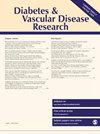Diabetes mellitus does not alter mortality or hospitalisation risk in patients with newly diagnosed heart failure with preserved ejection fraction: Time to rethink pathophysiological models of disease progression
IF 3
4区 医学
Q3 ENDOCRINOLOGY & METABOLISM
引用次数: 0
Abstract
IntroductionType 2 diabetes is a common and adverse prognostic co-morbidity for patients with heart failure with reduced ejection fraction (HFrEF). The effect of diabetes on long-term outcomes for heart failure with preserved ejection fraction (HFpEF) is less established.MethodsProspective cohort study of patients referred to a regional HF clinic with newly diagnosed with HFrEF and HFpEF according to the 2016 European Society of Cardiology guidelines. The association between diabetes, all-cause mortality and hospitalisation was quantified using Kaplan-Meier or Cox regression analysis.ResultsBetween 1st May 2012 and 1st May 2013, of 960 unselected consecutive patients referred with suspected HF, 464 and 314 patients met the criteria for HFpEF and HFrEF respectively. Within HFpEF and HFrEF groups, patients with diabetes were more frequently male and in both groups patients with diabetes were more likely to be treated with β-adrenoceptor antagonists and angiotensin converting enzyme inhibitors. After adjustment for age, sex, medical therapy and co-morbidities, diabetes was associated with increased mortality in individuals with HFrEF (HR 1.46 95% CI: 1.05–2.02; p = .023), but not in those with HFpEF (HR 1.26 95% CI 0.92–1.72; p = .146).ConclusionIn unselected patients with newly diagnosed HF, diabetes is not an adverse prognostic marker in patients with HFpEF, but is in HFrEF.糖尿病不会改变新诊断的射血分数保留型心力衰竭患者的死亡率或住院风险:是时候重新思考疾病进展的病理生理学模型了
导言2型糖尿病是射血分数降低型心力衰竭(HFrEF)患者常见的不良预后合并症。糖尿病对射血分数保留型心力衰竭(HFpEF)长期预后的影响尚不明确。方法对根据2016年欧洲心脏病学会指南转诊至地区性心力衰竭诊所的新诊断为HFrEF和HFpEF的患者进行前瞻性队列研究。结果2012年5月1日至2013年5月1日期间,在960名未经筛选的连续转诊疑似高频患者中,分别有464名和314名患者符合HFpEF和HFrEF标准。在HFpEF和HFrEF组中,糖尿病患者多为男性,而在这两组患者中,糖尿病患者更有可能接受β肾上腺素受体拮抗剂和血管紧张素转换酶抑制剂治疗。在对年龄、性别、药物治疗和合并疾病进行调整后,糖尿病与HFrEF患者死亡率的增加有关(HR 1.46 95% CI: 1.05-2.02; p = .023),但与HFpEF患者的死亡率增加无关(HR 1.26 95% CI 0.92-1.72; p = .146)。
本文章由计算机程序翻译,如有差异,请以英文原文为准。
求助全文
约1分钟内获得全文
求助全文
来源期刊

Diabetes & Vascular Disease Research
ENDOCRINOLOGY & METABOLISM-PERIPHERAL VASCULAR DISEASE
CiteScore
4.40
自引率
0.00%
发文量
33
审稿时长
>12 weeks
期刊介绍:
Diabetes & Vascular Disease Research is the first international peer-reviewed journal to unite diabetes and vascular disease in a single title. The journal publishes original papers, research letters and reviews. This journal is a member of the Committee on Publication Ethics (COPE)
 求助内容:
求助内容: 应助结果提醒方式:
应助结果提醒方式:


